
Nearly all living things — fish or fowl, human or humpback whale — encounter industrial chemicals all the time, and whether this contact is harmful, lethal, or harmless largely depends on the amount of exposure.
For example, it’s known that exposure to triphenyl phosphate (TPhP), a chemical used as a fire retardant and in some nail polish, is harmful to humans and aquatic species at relatively high levels, and the U.S. Environmental Protection Agency has been conducting a risk evaluation of the chemical in recent years.
Now comes new research from a Bates team comprising Associate Professor of Biology Larissa Williams and three recent graduates, who have done the first examination of the effect of TPhP exposure in everyday life, a level known as “environmentally relevant concentrations,” discovering that everyday exposure to TPhP is harmful to zebrafish embryos and larvae — and, potentially, to human beings as well.’

Published as the cover article in the May 2024 issue of the journal Toxics, their paper, “Environmentally Relevant Concentrations of Triphenyl Phosphate (TPhP) Impact Development in Zebrafish,” was named an Editor’s Choice by the journal for its interest to readers and research importance.
Williams’ coauthors are Bates alumni Ben Schmandt ’22, Gabrielle Smart ’23, and Mfon Diduff ’24, each of whom contributed to the research while working in the Williams lab as students.
Spanning three years, the Bates research project studied TPhP exposure on zebrafish, a species that shares around 80 to 85 percent of its DNA with humans, making it an effective model for research on the effects of toxicants on both aquatic species and humans.
“With toxicants, if you throw enough at [an organism], there will be an effect. But that doesn’t make it relevant. That’s why this paper is particularly exciting.”
Larissa Williams
In the findings, says Williams, send a clarion call for more research. “We know that TPhP is a ubiquitous environmental contaminant that many organisms, including humans, are exposed to. Now we know that it is likely a developmental toxicant at environmentally relevant levels. That’s worrisome. It’s critical to understand the implications of that exposure.”
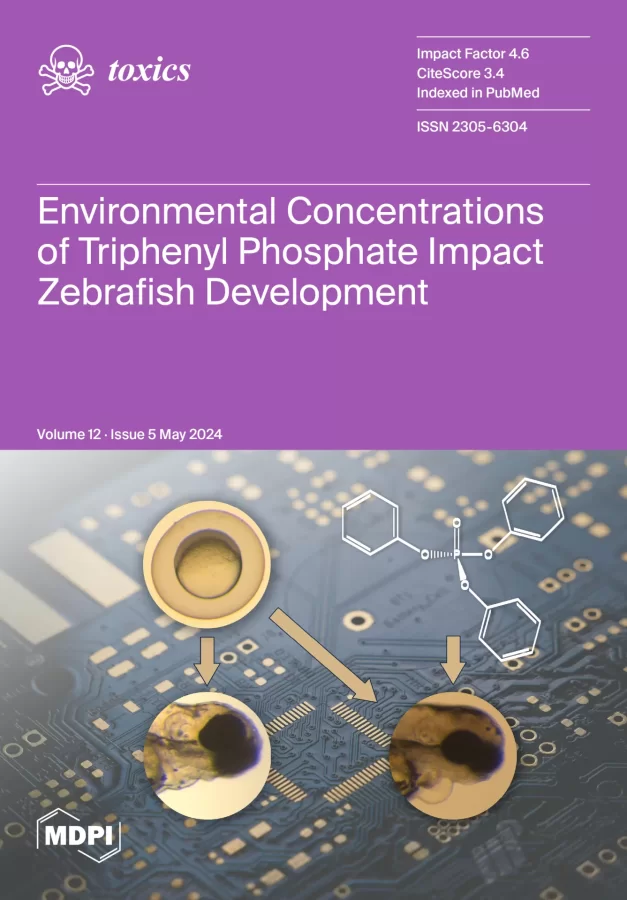
The Bates research exposed zebrafish to TPhP at everyday levels, which is in parts per billion, rather than parts per million, which most researchers have focused on.
“We were looking at exposure at the nanomolar level, a thousand times less concentrated than other studies had reported,” says Williams. “With toxicants, if you throw enough at [an organism], there will be an effect. But that doesn’t make it relevant. That’s why this paper is particularly exciting.”
The team discovered that parts-per-billion TPhP exposure harmfully affected developing zebrafish through multiple biological pathways, though the exact harmful mechanism is still not fully understood.
They found that TPhP-exposed zebrafish larvae were stunted in size and suffered from heart swelling (pericardial edema), both of which are also seen at higher exposure levels. The fish also suffered from oxidative stress, causing cell damage within hours of exposure.
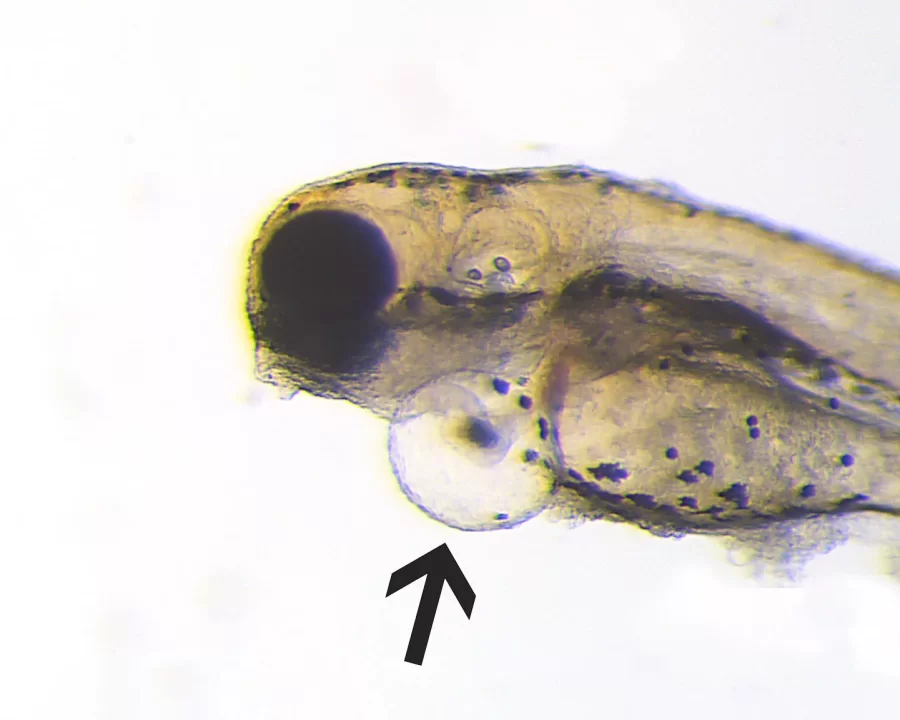
Like many research endeavors, the Bates project got inspiration from how researchers like Williams have long-running and productive collaborations with fellow researchers far from Bates.
Years ago, while reviewing a scholarly paper for a journal, Williams came across triphenyl phosphate “as a novel obesogen, which is a chemical that interacts with your endocrine system or your hormonal system.”
That led to conversations with two researcher collaborators who have expertise with toxicants, Kari Sant of Michigan State University and Alicia Timme-Laragy of the University of Massachusetts Amherst. Williams asked Sant, who is an expert in obesogens, “Do we know much about triphenyl phosphate in zebrafish?” “Not a ton,” Sant replied. “You should go for it.’”
Fast forward to the start of the 2021–22 academic year, the senior year of Ben Schmandt ’22, and a conversation between Williams and Schmandt about their senior thesis project. Williams suggested looking at TPhP. “Ben looked into the literature and found the level at which TPhP is found in surface waters. So that’s where we started, at the nanomolar level, a thousand times less than the micromolar level that everyone else has been working on.”
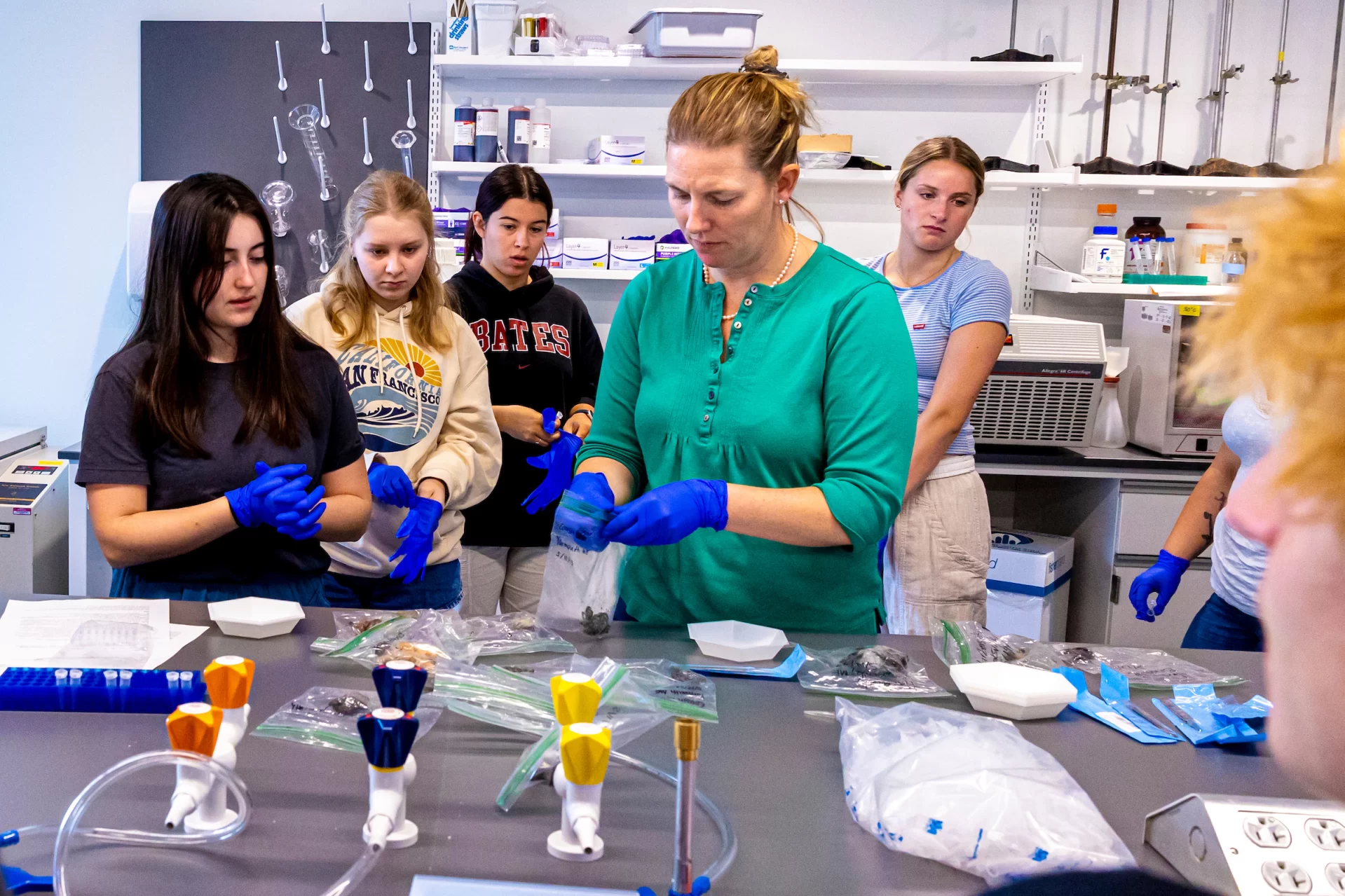
Williams credits Schmandt for bringing urgency to the project. “Ben was interested then, and continues to be interested now, in environmental contaminants. It was very important that the project be relevant, indicative of concentrations of this chemical that aquatic organisms see — that we get exposed to — versus levels that are already known to have an effect.”
She says the project was “right up Ben’s alley, in terms of interest. Ben really ran with it. And then we further ran with it with Gabby and Mfon.”
“It’s been an amazing labor of love to turn a research project into a scientific publication,” said Schmandt, who is now a research associate in the Claussnitzer Lab at the Broad Institute, working to understand how our genetic backgrounds impact the likelihood of developing heart disease. “I know I wouldn’t be doing this work today without everything I learned from working with Larissa, Mfon, and Gabby on this project.”
As an undergraduate at Bates, Schmandt “felt torn for a long time between a love for the environment and a passion for laboratory work.” The TPhP project united those two adversaries. “I found a passion for the specific ways the environment and genetics interact. Across contexts of pollution and disease, these interactions highlight just how little we still understand about how our surroundings impact us through our genes — that’s the mystery that brings purpose to my research.”
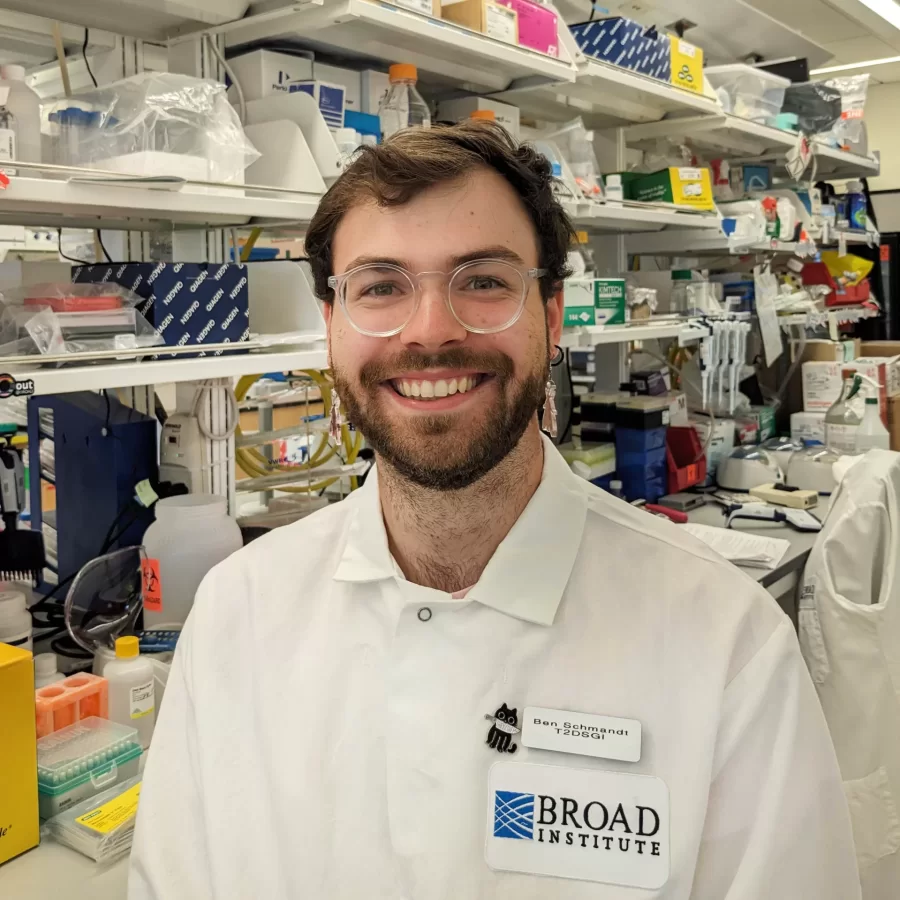
The research, conducted in Williams’ lab at the Bonney Science Center, involved exposing zebrafish larvae to TPhP over five days, a sufficient span to measure the chemical’s effects on this fast-growing species. That’s another reason that zebrafish are a magically effective research model. They grow from larva to adult in just 90 days, and are transparent. “At the age of 48 hours, zebrafish have produced hemoglobin, so we can see the heart,” Williams says.
The Bates researchers photographed and measured the size of the larvae by looking at them under a stereoscope in Williams lab. The team then measured heart rates manually, observing each beat. Using a stopwatch, the researcher counts the number of heartbeats within a 30-second interval. The researchers also checked for swelling around the heart and scored it on a scale from 1 (severe swelling) to 5 (normal). And, to see if the chemical affected blood circulation, they used another microscope to capture heart movement and blood flow in the larvae.
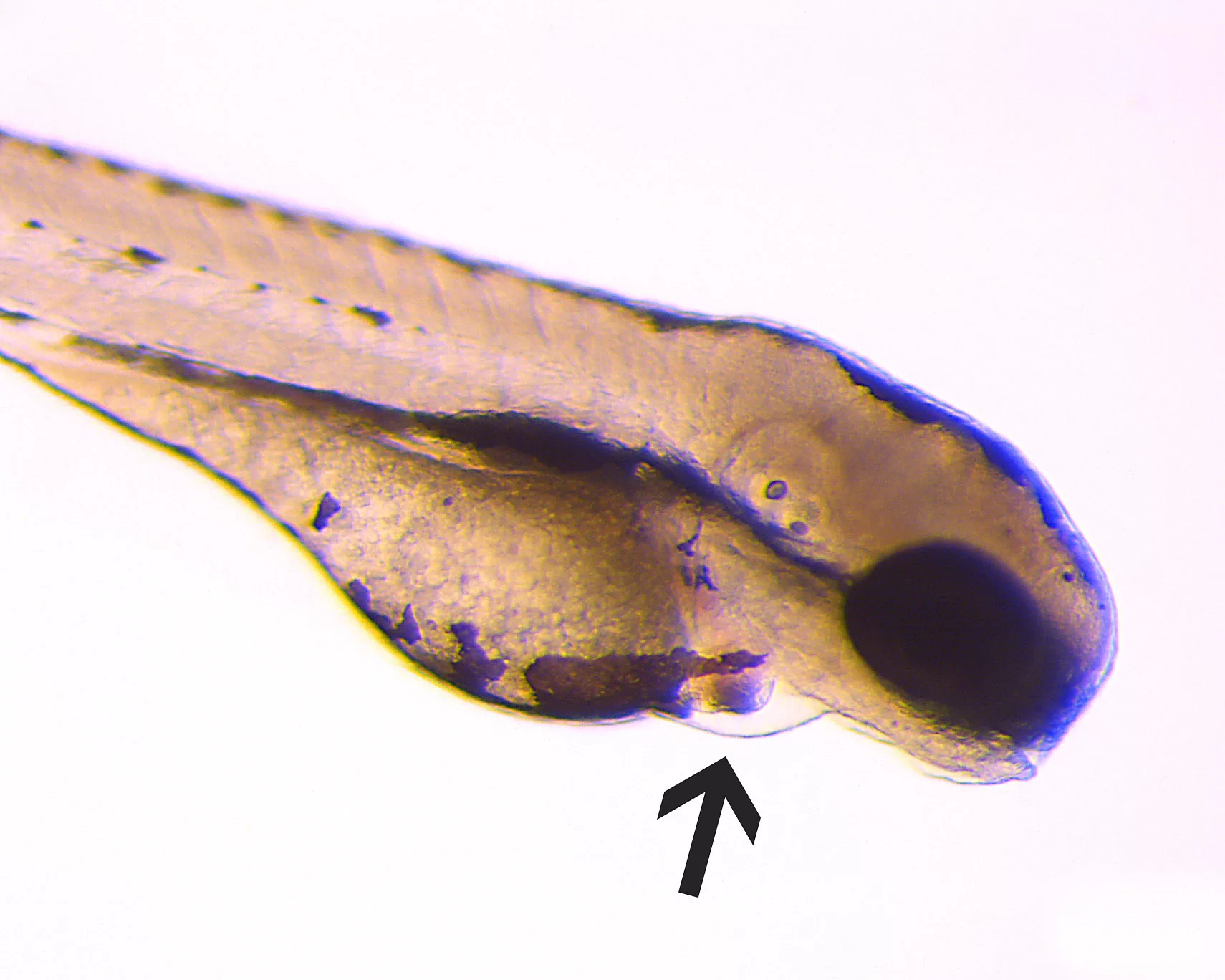
Among other takeaways, the Bates research success shines light on the college’s innovative and successful STEM Scholars program — which, along with other initiatives at Bates — has opened pathways and removed barriers for students interested in science, including coauthor and recent graduate Mfon Diduff, who majored in biochemistry.
She is now a research technician at Columbia University Irving Medical Center with eyes on a medical career. “I had always loved science but never saw myself doing scientific research in the lab,” she says.

Contributing to the research paper, specifically how TPhP in the environment negatively impacts overall organ development, has inspired her to learn “more about the factors that contribute to our health, specifically maternal health, as I intend on becoming an OB-GYN.”
She now has a vision of her future self. “I absolutely see being that physician who tends to the needs of her patients while also being a researcher who goes above and beyond to know why we see such occurrences that pose imminent danger in medicine and public health.”
Each of the coauthors, said Williams, used the project to further their path toward purposeful work. Schmandt was inspired by the environmental science side, Diduff by the public health aspect, and Gabby Smart ’23, now in veterinary school at Washington State, “was really excited to be working with animals, which we find with a lot of our pre-vet students prior to vet school.”
Smart notes that “animals may even be more affected by some of the chemicals we researched. Being in the veterinary field gives me a front row seat on how exposure to such chemicals affect animal health and longevity. I hope to continue to be an advocate for both environmental and animal health, which in turn will have a positive impact on human health.”
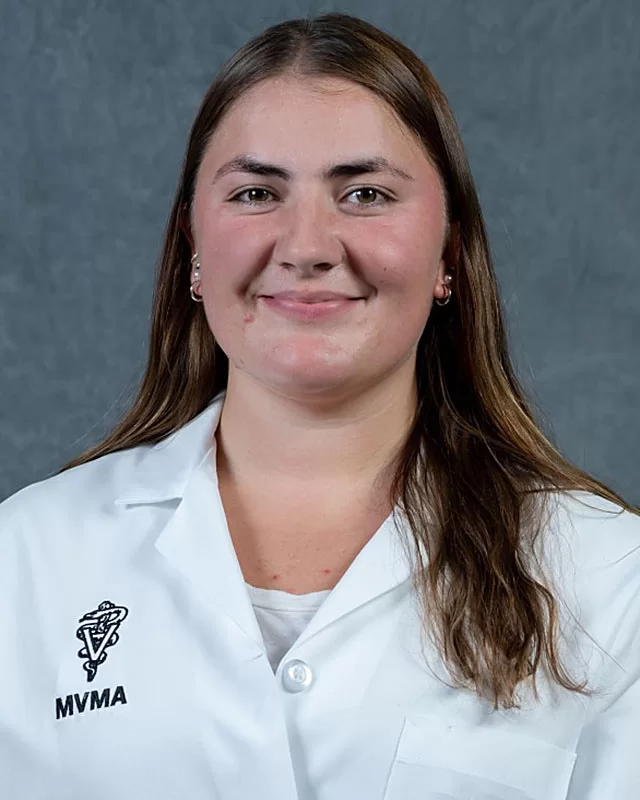
For the Williams lab, the next chapter in the research is to zero in on how and when TPhP does what it does to developing animals.
All developing animals, whether zebrafish larvae or human fetuses, “are exposed to a lot of different chemicals,” she explains. “It’s really the timing of that exposure that really matters, what we call the window of susceptibility.”
Alcohol is a familiar example. “Alcohol in a human fetus is highly toxic very early in pregnancy, but becomes less toxic as the fetus develops. If there is exposure early on, it has a much larger impact than later on. Many chemicals work that way. Part of what we do in our lab is to figure out that window.”
With a new grant from Maine INBRE, the lab will do more precise toxicant testing at different stages of zebrafish development. “We were able to show that chronic exposure over the entire developmental period impacted them. Now what we want to know is, as the heart’s developing and you add a toxicant, how does that change the trajectory of development?”
That knowledge “will help us unpack the biological mechanisms behind the phenotypes that we’re seeing. That will be data used by my thesis students this coming year.”
Faculty Featured

Larissa M. Williams
Professor of Biology




